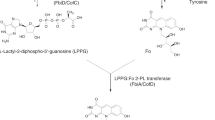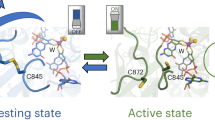Abstract
Escherichia coli can perform two modes of formate metabolism. Under respiratory conditions, two periplasmically-located formate dehydrogenase isoenzymes couple formate oxidation to the generation of a transmembrane electrochemical gradient; and under fermentative conditions a third cytoplasmic isoenzyme is involved in the disproportionation of formate to CO2 and H2. The respiratory formate dehydrogenases are redox enzymes that comprise three subunits: a molybdenum cofactor- and FeS cluster-containing catalytic subunit; an electron-transferring ferredoxin; and a membrane-integral cytochrome b. The catalytic subunit and its ferredoxin partner are targeted to the periplasm as a complex by the twin-arginine transport (Tat) pathway. Biosynthesis of these enzymes is under control of an accessory protein termed FdhE. In this study, it is shown that E. coli FdhE interacts with the catalytic subunits of the respiratory formate dehydrogenases. Purification of recombinant FdhE demonstrates the protein is an iron-binding rubredoxin that can adopt monomeric and homodimeric forms. Bacterial two-hybrid analysis suggests the homodimer form of FdhE is stabilized by anaerobiosis. Site-directed mutagenesis shows that conserved cysteine motifs are essential for the physiological activity of the FdhE protein and are also involved in iron ligation.




Similar content being viewed by others
Abbreviations
- DMSO:
-
Dimethyl sulphoxide
- EPR:
-
Electron paramagnetic resonance
- SPA:
-
Sequential peptide affinity
- Tat:
-
Twin-arginine translocation pathway
- TMAO:
-
Trimethylamine N-oxide
References
Abaibou H, Pommier J, Benoit S, Giordano G, Mandrand-Berthelot MA (1995) Expression and characterization of the Escherichia coli fdo locus and a possible physiological role for aerobic formate dehydrogenase. J Bacteriol 177:7141–7149
Baar C, Eppinger M, Raddatz G, Simon J, Lanz C, Klimmek O, Nandakumar R, Gross R, Rosinus A, Keller H, Jagtap P, Linke B, Meyer F, Lederer H, Schuster SC (2003) Complete genome sequence and analysis of Wolinella succinogenes. Proc Natl Acad Sci USA 100:11690–11695
Berks BC (1996) A common export pathway for proteins binding complex redox cofactors? Mol Microbiol 22:393–404
Berks BC, Palmer T, Sargent F (2003) The Tat protein translocation pathway and its role in microbial physiology. Adv Microb Physiol 47:187–254
Berg BL, Li J, Heider J, Stewart V (1991) Nitrate-inducible formate dehydrogenase in Escherichia coli K-12. I. Nucleotide sequence of the fdnGHI operon and evidence that opal (UGA) encodes selenocysteine. J Biol Chem 266:22380–22385
Bertero MG, Rothery RA, Palak M, Hou C, Lim D, Blasco F, Weiner JH, Strynadka NC (2003) Insights into the respiratory electron transfer pathway from the structure of nitrate reductase-A. Nat Struct Biol 10:681–687
Boyington JC, Gladyshev VN, Khangulov SV, Stadtman TC, Sun PD (1997) Crystal structure of formate dehydrogenase H: catalysis involving Mo, molybdopterin, selenocysteine, and an Fe4S4 cluster. Science 275:1305–1308
Butland G, Peregrín-Alvarez JM, Li J, Yang W, Yang X, Canadien V, Starostine A, Richards D, Beattie B, Krogan N, Davey M, Parkinson J, Greenblatt JF, Emili A (2005) Interaction network containing conserved and essential protein complexes in Escherichia coli. Nature 433:531–537
Casadaban MJ, Cohen SN (1979) Lactose genes fused to exogenous promoters in one step using a Mu-lac bacteriophage: in vivo probe for transcriptional control sequences. Proc Natl Acad Sci USA 76:4530–4533
Cristóbal S, de Gier JW, Nielsen H, von Heijne G (1999) Competition between Sec- and Tat-dependent protein translocation in Escherichia coli. EMBO J 18:2982–2990
Enoch HG, Lester RL (1975) The purification and properties of formate dehydrogenase and nitrate reductase from Escherichia coli. J Biol Chem 250:6693–6705
Hagelueken G, Wiehlmann L, Adams TM, Kolmar H, Heinz DW, Tümmler B, Schubert WD (2007) Crystal structure of the electron transfer complex rubredoxin rubredoxin reductase of Pseudomonas aeruginosa. Proc Natl Acad Sci USA 104:12276–12281
Hamilton CM, Aldea M, Washburn BK, Babitzke P, Kushner SR (1989) New method for generating deletions and gene replacements in Escherichia coli. J Bacteriol 171:4617–4622
Hatzixanthis K, Palmer T, Sargent F (2003) A subset of bacterial inner membrane proteins integrated by the twin-arginine translocase. Mol Microbiol 49:1377–1390
Hatzixanthis K, Clarke TA, Oubrie A, Richardson DJ, Turner RJ, Sargent F (2005) Signal peptide-chaperone interactions on the twin-arginine protein transport pathway. Proc Natl Acad Sci USA 102:8460–8465
Hicks MG, Lee PA, Georgiou G, Berks BC, Palmer T (2005) Positive selection for loss-of-function tat mutations identifies critical residues required for TatA activity. J Bacteriol 187:2920–2925
Jack RL, Buchanan G, Dubini A, Hatzixanthis K, Palmer T, Sargent F (2004) Co-ordinating assembly and export of complex bacterial proteins. EMBO J 23:3962–3972
Jormakka M, Törnroth S, Byrne B, Iwata S (2002) Molecular basis of proton motive force generation: structure of formate dehydrogenase-N. Science 295:1863–1868
Jormakka M, Richardson DJ, Byrne B, Iwata S (2004) Architecture of NarGH reveals a structural classification of Mo-bisMGD enzymes. Structure 12:95–104
Karimova G, Pidoux J, Ullmann A, Ladant D (1998) A bacterial two-hybrid system based on a reconstituted signal transduction pathway. Proc Natl Acad Sci USA 95:5752–5756
Karimova G, Ullmann A, Ladant D (2001) Protein-protein interaction between Bacillus stearothermophilus tyrosyl-tRNA synthetase subdomains revealed by a bacterial two-hybrid system. J Mol Microbiol Biotechnol 3:73–82
Kisker C, Schindelin H, Rees DC (1997) Molybdenum-cofactor-containing enzymes: structure and mechanism. Annu Rev Biochem 66:233–267
Kröger A, Biel S, Simon J, Gross R, Unden G, Lancaster CR (2002) Fumarate respiration of Wolinella succinogenes: enzymology, energetics and coupling mechanism. Biochim Biophys Acta 1553:23–38
Lämmli UK (1970) Cleavage of structural proteins during the assembly of the head of bacteriophage T4. Nature 277:680–685
Lanciano P, Vergnes A, Grimaldi S, Guigliarelli B, Magalon A (2007) Biogenesis of a respiratory complex is orchestrated by a single accessory protein. J Biol Chem 282:17468–17474
Lowry OH, Rosebrough NJ, Farr AL, Randall RJ (1951) Protein measurement with the Folin phenol reagent. J Biol Chem 193:265–275
Maillard J, Spronk CAEM, Buchanan G, Lyall V, Richardson DJ, Palmer T, Vuister GW, Sargent F (2007) Structural diversity in twin-arginine signal peptide-binding proteins. Proc Natl Acad Sci USA 104:15641–15646
Mandrand-Berthelot MA, Couchoux-Luthaud G, Santini CL, Giordano G (1988) Mutants of Escherichia coli specifically deficient in respiratory formate dehydrogenase activity. J Gen Microbiol 134:3129–3139
McDevitt CA, Hugenholtz P, Hanson GR, McEwan AG (1997) Molecular analysis of dimethyl sulphide dehydrogenase from Rhodovulum sulfidophilum: its place in the dimethyl sulphoxide reductase family of microbial molybdopterin-containing enzymes. Mol Microbiol 44:1575–1587
Oresnik IJ, Ladner CL, Turner RJ (2001) Identification of a twin-arginine leader-binding protein. Mol Microbiol 40:323–331
Palmer T, Sargent F, Berks BC (2005) Export of complex cofactor-containing proteins by the bacterial Tat pathway. Trends Microbiol 13:175–180
Peisach J, Blumberg WE, Lode ET, Coon MJ (1971) An analysis of the electron paramagnetic resonance spectrum of Pseudomonas oleovorans rubredoxin. A method for determination of the ligands of ferric iron in completely rhombic sites. J Biol Chem 246:5877–5881
Punginelli C, Ize B, Stanley NR, Stewart V, Sawers G, Berks BC, Palmer T (2004) mRNA secondary structure modulates translation of Tat-dependent formate dehydrogenase-N. J Bacteriol 186:6311–6315
Raaijmakers HC, Romão MJ (2006) Formate-reduced E. coli formate dehydrogenase H: the reinterpretation of the crystal structure suggests a new reaction mechanism. J Biol Inorg Chem 11:849–854
Richardson DJ, Sawers G (2002) PMF through the redox loop. Science 295:1842–1843
Sargent F (2007a) The twin-arginine transport system: moving folded proteins across membranes. Biochem Soc Trans 35:835–847
Sargent F (2007b) Constructing the wonders of the bacterial world: biosynthesis of complex enzymes. Microbiology 153:633–651
Sawers G (1994) The hydrogenases and formate dehydrogenases of Escherichia coli. Antonie van Leeuwenhoek 66:57–88
Schlindwein C, Giordano G, Santini CL, Mandrand MA (1990) Identification and expression of the Escherichia coli fdhD and fdhE genes, which are involved in the formation of respiratory formate dehydrogenase. J Bacteriol 172:6112–6121
Schlindwein C, Mandrand MA (1991) Nucleotide sequence of the fdhE gene involved in respiratory formate dehydrogenase formation in Escherichia coli K-12. Gene 97:147–148
Stanley NR, Sargent F, Buchanan G, Shi J, Stewart V, Palmer T, Berks BC (2002) Behaviour of topological marker proteins targeted to the Tat protein transport pathway. Mol Microbiol 43:1005–1021
Stewart V, Lin JT, Berg BL (1991) Genetic evidence that genes fdhD and fdhE do not control synthesis of formate dehydrogenase-N in Escherichia coli K-12. J Bacteriol 173:4417–4423
Towbin H, Staehelin T, Gordon J (1979) Electrophoretic transfer of proteins from polyacrylamide gels to nitrocellulose sheets: procedure and some applications. Proc Natl Acad Sci USA 76:4350–4354
Tullman-Ercek D, DeLisa MP, Kawarasaki Y, Iranpour P, Ribnicky B, Palmer T, Georgiou G (2007) Export pathway selectivity of Escherichia coli twin arginine translocation signal peptides. J Biol Chem 282:8309–8316
Turner RJ, Papish AL, Sargent F (2004) Sequence analysis of bacterial redox enzyme maturation proteins (REMPs). Can J Microbiol 50:225–238
Vergnes A, Pommier J, Toci R, Blasco F, Giordano G, Magalon A (2006) NarJ chaperone binds on two distinct sites of the aponitrate reductase of Escherichia coli to co-ordinate molybdenum cofactor insertion and assembly. J Biol Chem 281:2170–2176
Yu D, Ellis HM, Lee EC, Jenkins NA, Copeland NG, Court DL (2000) An efficient recombination system for chromosome engineering in Escherichia coli. Proc Natl Acad Sci USA 97:5978–5983
Zeghouf M, Li J, Butland G, Borkowska A, Canadien V, Richards D, Beattie B, Emili A, Greenblatt JF (2004) Sequential Peptide Affinity (SPA) system for the identification of mammalian and bacterial protein complexes. J Proteome Res 3:463–468
Acknowledgments
M. G. Hicks (John Innes Centre, Norwich) is thanked for performing some preliminary enzyme assays and W. Yang, X. Yang, S. Chandran and P. Wong (University of Toronto) are thanked for technical assistance. This work was funded in the UK by the BBSRC through awards BB/C006844/2 and BBS/S/P/2003/10319 (to FS) and a grant-in-aid to the John Innes Centre, Norwich. TP is an MRC Senior Non-Clinical Research Fellow and FS is a Royal Society University Research Fellow.
Author information
Authors and Affiliations
Corresponding author
Additional information
Communicated by Theo Hansen.
Rights and permissions
About this article
Cite this article
Lüke, I., Butland, G., Moore, K. et al. Biosynthesis of the respiratory formate dehydrogenases from Escherichia coli: characterization of the FdhE protein. Arch Microbiol 190, 685–696 (2008). https://doi.org/10.1007/s00203-008-0420-4
Received:
Revised:
Accepted:
Published:
Issue Date:
DOI: https://doi.org/10.1007/s00203-008-0420-4




